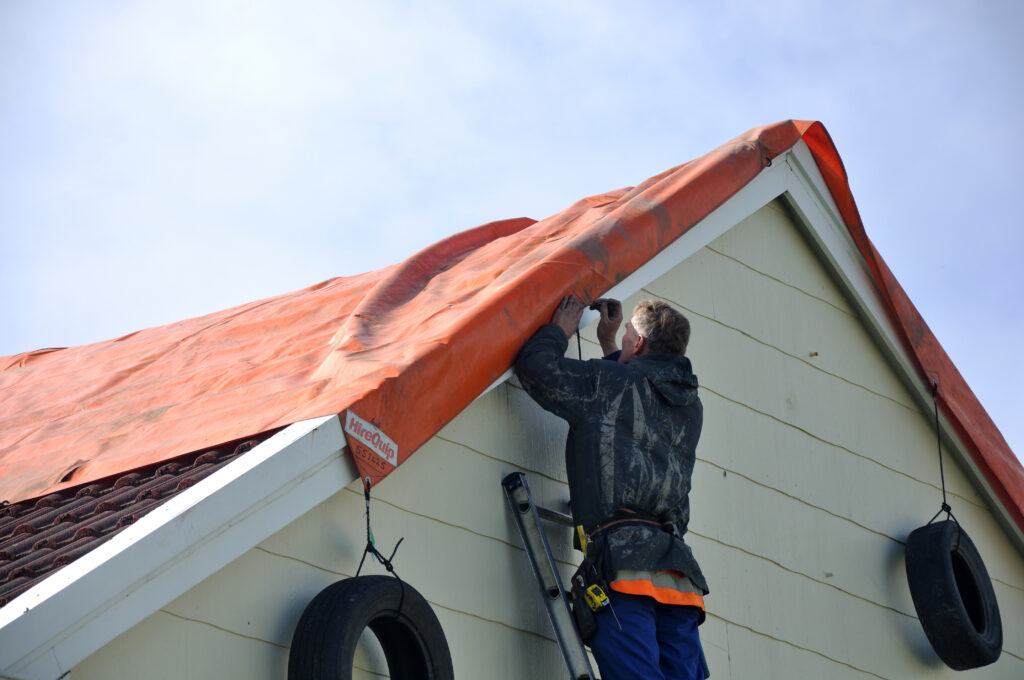When disaster strikes, be it a powerful storm, hailstorm, or hurricane, your roof often bears the brunt of nature’s fury. It’s in the aftermath that you realize the true importance of a structurally sound roof. Neglecting post-disaster roof damage can lead to more significant problems down the line, affecting your home’s structural integrity and your family’s safety.
In this guide, we will walk you through the crucial steps of assessing and addressing roofing issues after a disaster, ensuring that your home remains a safe haven.
Types of Roof Damage After a Disaster
Wind Damage
Wind damage is a common occurrence during storms and hurricanes. The strong winds can wreak havoc on your roof, causing shingles to lift or tear off completely.
To assess wind damage, start with a visual inspection. Look for damaged shingles, loose flashing, and gutter problems. Don’t forget to also check your attic for signs of water infiltration, as wind-driven rain can find its way inside.
Hail Damage
Hail is another natural force that can cause significant damage to your roof. Hailstones can dent or bruise shingles, leading to vulnerabilities that may result in leaks over time.
Inspect your roof for shingle bruising and granule loss. Keep in mind that hail damage may not be immediately obvious, so a thorough examination is crucial.
Water Damage
While wind and hail damage can directly affect your roof, water damage can be the most insidious consequence of a disaster. Water can infiltrate even the tiniest gaps, causing extensive damage over time.
Signs of water damage include leaks, water stains on ceilings or walls, and sagging areas on your roof. Promptly addressing water damage is essential to prevent further deterioration.
Assessing the Damage
Before taking any action, gather the necessary tools for a comprehensive inspection. A sturdy ladder, flashlight, safety gear (including gloves and a helmet), and binoculars for a safer assessment are essential. Safety should always be a top priority when inspecting your roof post-disaster.
Begin with an exterior inspection. Examine your shingles, flashing, and gutters closely. Look for loose or damaged shingles and clogged gutters. Pay attention to any debris or tree limbs that may have punctured the roof.
Follow up with an interior inspection, which involves checking the attic and ceilings for signs of damage. Look for wet insulation, water stains, and any visible light coming through the roof. Document your findings with photos and notes to provide a clear picture of the damage.
Safety Precautions
While assessing damage, remember that your safety should always come first. It’s crucial to avoid attempting any DIY repairs, especially in dangerous conditions. A slippery roof or unstable structure can lead to accidents and further damage. Instead, if you discover significant damage or hazards, call professionals immediately. Roofing experts are equipped to handle these situations safely and efficiently.
Temporary Repairs
In many cases, it’s necessary to perform temporary repairs to mitigate immediate damage. Temporary repairs can prevent further water infiltration and deterioration while you arrange for permanent solutions.
Common temporary repair methods include using tarps to cover damaged areas, patching holes, and sealing gaps. These measures provide a temporary shield against the elements until you can proceed with permanent repairs.
Hiring a Professional Roofing Contractor
For lasting solutions, hiring a professional roofing contractor is highly recommended. When selecting a contractor, consider their licensing, insurance, references, and reviews. Ask for multiple quotes to compare pricing and evaluate the warranty offered on their work. A reputable contractor will discuss your options and guide you through the process, ensuring your roof is restored to its pre-disaster condition.
Insurance Claims
Dealing with insurance is often a necessary step in the roof repair process. When filing an insurance claim, proper documentation is essential. Take clear photographs of the damage and keep detailed notes on the extent of the destruction. When an adjuster visits your property, be present and provide them with all necessary information. Understanding your insurance policy and the claims process can help expedite the repair process.
Permanent Roof Repairs
While temporary fixes can provide immediate relief, it’s crucial to consider permanent roof repairs for long-term stability. The inspection of the damage will determine whether a partial or full replacement is necessary.
Trust your chosen contractor to assess the situation and recommend the most suitable solution. Permanent repairs not only restore your roof’s integrity but also enhance its durability and longevity.
Preventative Measures for the Future
Once your roof is restored, it’s essential to take preventative measures to minimize the risk of future disasters. Regular roof maintenance, such as cleaning gutters, trimming overhanging branches, and inspecting for wear and tear, can go a long way in preventing damage. Additionally, consider reinforcing your roof with impact-resistant materials for added protection.
Safeguarding Your Roof and Home
Your roof plays a crucial role in safeguarding your home and family. After a disaster, assessing and addressing roofing issues promptly is paramount. By following the steps outlined, you can ensure the safety and longevity of your roof.
Remember that safety should always be a priority, and when in doubt, consult a professional roofing contractor to guide you through the repair process. With the right approach, your home will weather any storm that comes its way.
To delve into the ways in which HW Roofing can serve your roofing needs effectively, we invite you to initiate the process by booking an inspection. This invaluable assessment will provide you with vital insights, enabling you to make well-informed decisions regarding your roofing requirements.



